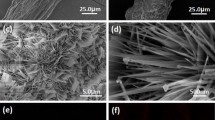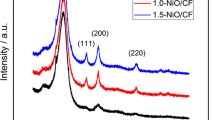Abstract
Carbon fibers, with reduced oxidized graphite layers on the surface obtained using a facile method, were developed as one-dimensional electrodes. The oxidized layers directly formed from the surface of the carbon fibers had a strong interconnectivity with the fiber core, and their conductivity was apparently improved after reduction by hydrazine hydrate. With an abundance of oxygen functional groups induced by oxidation, the one-dimensional electrodes showed a specific capacitance of 213.3 F g−1 at a current density of 0.1 A g−1, which was forty times more than that of the original carbon fibers when tested in a three-electrode configuration. The innately stability in aqueous solutions and the graphite layers from the carbon fibers themselves made the electrodes based on the carbon fibers endowed optimal cycling ability without a decline in specific capacitance after 10000 cycles. The device made of CF-R had a good energy density performance. This strategy provided a facile way to obtain a one-dimensional electrode with a high specific capacitance and good durability for energy storage systems.








Similar content being viewed by others
References
Simon P, Gogotsi Y (2008) Materials for electrochemical capacitors. Nat Mater 7(11):845–854
Zhang LL, Zhao XS (2009) Carbon-based materials as supercapacitor electrodes. Chem Soc Rev 38(9):2520–2531
Wang G, Zhang L, Zhang J (2012) A review of electrode materials for electrochemical supercapacitors. Chem Soc Rev 41(2):797–828
Denisa H-J, Seredych M, Lu GQ, Bandosz TJ (2009) Combined effect of nitrogen- and oxygen-containing functional groups of microporous activated carbon on its electrochemical performance in supercapacitors. Adv Funct Mater 19(3):438–447
Kossyrev P (2012) Carbon black supercapacitors employing thin electrodes. J Power Sources 201:347–352
Kang D, Liu Q, Gu J, Su Y, Zhang W, Zhang D (2015) “Egg-Box”-assisted fabrication of porous carbon with small mesopores for high-rate electric double layer capacitors. ACS Nano 9(11):11225–11233
Xu P, Gu TL, Cao ZY, Wei BQ, Yu JQ, Li FX, Byun JH, Lu WB, Li Q, Chou TW (2014) Carbon nanotube fiber based stretchable wire-shaped supercapacitors. Adv Energy Mater 4(3):1–7
Ji J, Liu J, Lai L, Zhao X, Zhen Y, Lin J, Zhu Y, Ji H, Zhang LL, Ruoff RS (2015) In situ activation of nitrogen-doped graphene anchored on graphite foam for a high-capacity anode. ACS Nano 9(8):8609–8616
Ji J, Li Y, Peng W, Zhang G, Zhang F, Fan X (2015) Advanced graphene-based binder-free electrodes for high-performance energy storage. Adv Mater 27(36):5264–5279
Wang Y, Yu F, Zhu M, Ma C, Zhao D, Wang C, Zhou A, Dai B, Ji J, Guo X (2018) N-Doping of plasma exfoliated graphene oxide via dielectric barrier discharge plasma treatment for the oxygen reduction reaction. J Mater Chem A 6(5):2011–2017
Zhang J, Zhao X, Huang Z, Xu T, Zhang Q (2016) High-performance all-solid-state flexible supercapacitors based on manganese dioxide/carbon fibers. Carbon 107:844–851
Zhu S, Li L, Liu J, Wang H, Wang T, Zhang Y, Zhang L, Ruoff RS, Dong F (2018) Structural directed growth of ultrathin parallel birnessite on β-MnO2 for high-performance asymmetric supercapacitors. ACS Nano 12(2):1033–1042
Bae J, Song MK, Park YJ, Kim JM, Liu M, Wang ZL (2011) Fiber supercapacitors made of nanowire-fiber hybrid structures for wearable/flexible energy storage. Angew Chem Int Ed 50(7):1683–1687
Arabale G, Wagh D, Kulkarni M, Mulla IS, Vernekar SP, Vijayamohanan K, Rao AM (2003) Enhanced supercapacitance of multiwalled carbon nanotubes functionalized with ruthenium oxide. Chem Phys Lett 376(1–2):207–213
Liang J, Yuan C, Li H, Fan K, Wei Z, Sun H, Ma J (2018) Growth of SnO2 nanoflowers on N-doped carbon nanofibers as anode for Li- and Na-ion batteries. Nano-Micro Lett 10(2):21
Liang J, Gao X, Guo J, Chen C, Fan K, Ma J (2018) Electrospun MoO2@NC nanofibers with excellent Li+/Na+ storage for dual applications. Sci China Mater 61(1):30–38
Deng X, Wei Z, Cui C, Liu Q, Wang C, Ma J (2018) Oxygen-deficient anatase TiO2@C nanospindles with pseudocapacitive contribution for enhancing lithium storage. J Mater Chem A 6(9):4013–4022
Xie Y, Xia C, Du H, Wang W (2015) Enhanced electrochemical performance of polyaniline/carbon/titanium nitride nanowire array for flexible supercapacitor. J Power Sources 286:561–570
Zhang K, Zhang LL, Zhao XS, Wu J (2010) Graphene/polyaniline nanofiber composites as supercapacitor electrodes. Chem Mater 22(4):1392–1401
Mini PA, Balakrishnan A, Nair SV, Subramanian KRV (2011) Highly super capacitive electrodes made of graphene/poly(pyrrole). Chem Commun 47(20):5753–5755
Laforgue A (2011) All-textile flexible supercapacitors using electrospun poly(3,4-ethylenedioxythiophene) nanofibers. J Power Sources 196(1):559–564
Nam S, Jang J, J-j Park, Kim SW, Park CE, Kim JM (2012) High-performance low-voltage organic field-effect transistors prepared on electro-polished aluminum wires. ACS Appl Mat Interfaces 4(1):6–10
Liu XY, Zhou M, Chen C, Zhang YX (2017) Electrochemical capacitor performance of TiO2 nanostructures and porous MnO2 composite supported on carbon fiber paper. Ceram Int 43(13):10595–10600
Szabó T, Berkesi O, Forgó P, Josepovits K, Sanakis Y, Petridis D, Dékány I (2006) Evolution of surface functional groups in a series of progressively oxidized graphite oxides. Chem Mater 18(11):2740–2749
Fuente E, Menéndez JA, Díez MA, Suárez D, Montes-Morán MA (2003) Infrared spectroscopy of carbon materials: a quantum chemical study of model. J Phys Chem B 107(26):6350–6359
Kudin KN, Ozbas B, Schniepp HC, Prud’homme RK, Aksay IA, Car R (2008) Raman spectra of graphite oxide and functionalized graphene sheets. Nano Lett 8(1):36–41
Galiotis C, Batchelder DN (1998) Strain dependences of the first- and second-order Raman spectra of carbon fibres. J Mater Sci Lett 7:545–547
Lespade P, Marchand A, Couzi M, Cruege F (1984) Caracterisation de materiaux carbones par microspectrometrie Raman. Carbon 22(4/5):375–385
Jeong H-K, Lee YP, Lahaye RJWE, Park M-H, An KH, Kim IJ, Yang C-W, Park CY, Ruoff RS, Lee YH (2008) Evidence of graphitic AB stacking order of graphite oxides. J Am Chem Soc 130(4):1362–1366
Artyushkova K, Kiefer B, Halevi B, Knop-Gericke A, Schloglc R, Atanassov P (2013) Density functional theory calculations of XPS binding energy shift for nitrogen-containing graphene-like structures. Chem Commun 49(25):2539–2541
Roldán S, Blanco C, Granda M, Menéndez R, Santamaría R (2011) Towards a further generation of high-energy carbon-based capacitors by using redox-active electrolytes. Angew Chem 50(7):1699–1701
Singh C, Paul A (2015) Physisorbed hydroquinone on activated charcoal as a supercapacitor: an application of proton-coupled electron transfer. J Phys Chem C 119(21):11382–11390
Lu X, Liu T, Zhai T, Wang G, Yu M, Xie S, Ling Y, Liang C, Tong Y, Li Y (2014) Improving the cycling stability of metal-nitride supercapacitor electrodes with a thin carbon shell. Adv Energy Mater 4(4):1300994
Kim DJ, Kim JK, Lee JH, Cho HH, Bae Y-S, Kim JH (2016) Scalable and bendable organized mesoporous TiN films templated by using a dual-functional amphiphilic graft copolymer for solid supercapacitors. J Mater Chem A 4(32):12497–12503
Ramanuja N, Levy RA, Dharmadhikari SN, Ramos E, Pearce CW, Menasian SC, Schamberger PC, Collins CC (2002) Synthesis and characterization of low pressure chemically vapor deposited titanium nitride films using TiCl4 and NH3. Mater Lett 57(2):261–269
Chmiola J, Largeot C, Taberna P-L, Simon P, Gogotsi Y (2008) Desolvation of ions in subnanometer pores and its effect on capacitance and double-layer theory. Angew Chem 120(18):3440–3443
Largeot C, Portet C, Chmiola J, Taberna P-L, Gogotsi Y, Simon P (2008) Relation between the ion size and pore size for an electric double-layer capacitor. J Am Chem Soc 130(9):2730–2731
Lozano-Castelló D, Cazorla-Amorós D, Linares-Solano A, Shiraishi S, Kurihara H, Oya A (2003) Influence of pore structure and surface chemistry on electric double layer capacitance in non-aqueous electrolyte. Carbon 41(9):1765–1775
Fang B, Binder L (2007) Influence of hydrophobisation of carbon surface on electrochemical capacitor performance. J Electroanal Chem 609(2):99–104
Guo M, Guo J, Jia D, Zhao H, Sun Z, Songa X, Lia Y (2015) Coal derived porous carbon fibers with tunable internal channels for flexible electrodes and organic matter absorption. J Mater Chem A 3(42):21178–21184
Frackowiaka E, Béguinb R (2001) Carbon materials for the electrochemical storage of energy in capacitors. Carbon 39(6):937–950
Xiao X, Li T, Yang P, Gao Y, Jin H, Ni W, Zhan W, Zhang X, Cao Y, Zhong J, Gong L, Yen W-C, Mai W, Chen J, Huo K, Chueh Y-L, Wang Z, Zhou J (2012) Fiber-based all-solid-state flexible supercapacitors for self-powered systems. ACS Nano 6(10):9200–9206
Xiao X, Ding T, Yuan L, Shen Y, Zhong Q, Zhang X, Cao Y, Hu B, Zhai T, Gong L, Chen J, Tong Y, Zhou J, Wang ZL (2012) WO3−x/MoO3−x core/shell nanowires on carbon fabric as an anode for all-solid-state asymmetric supercapacitors. Adv Energy Mater 2(11):1328–1332
Xu P, Gu T, Cao Z, Wei B, Yu J, Li F, Byun J-H, Lu W, Li Q, Chou T-W (2014) Carbon nanotube fiber based stretchable wire-shaped supercapacitors. Adv Energy Mater 4(3):1300759
Lu X, Yu M, Wang G, Zhai T, Xie S, Ling Y, Tong Y, Li Y (2013) H-TiO2@MnO2//H-TiO2@C core-shell nanowires for high performance and flexible asymmetric supercapacitors. Adv Mater 25(2):267–272
Xiao X, Peng X, Jin H, Li T, Zhang C, Gao B, Hu B, Huo K, Zhou J (2013) Freestanding mesoporous VN/CNT hybrid electrodes for flexible all-solid-state supercapacitors. Adv Mater 25(36):5091–5097
Yang P, Xiao X, Li Y, Ding Y, Qiang P, Tan X, Mai W, Lin Z, Wu W, Li T, Jin H, Liu P, Zhou J, Wong CP, Wang ZL (2013) Hydrogenated ZnO core-shell nanocables for flexible supercapacitors and self-powered systems. ASC Nano 7(3):2617–2626
Zheng H, Zhai T, Yu M, Xie S, Liang C, Zhao W, Wang SCI, Zhang Z, Lu X (2013) TiO2@C core–shell nanowires for high-performance and flexible solid-state supercapacitors. J Mater Chem C 1(2):225–229
Lu X, Yu M, Zhai T, Wang G, Xie S, Liu T, Liang C, Tong Y, Li Y (2013) High energy density asymmetric quasi-solid-state supercapacitor based on porous vanadium nitride nanowire anode. Nano Lett 13(6):2628–2633
Acknowledgements
This work was financially supported by the “DHU Distinguished Young Professor Program”.
Author information
Authors and Affiliations
Corresponding authors
Ethics declarations
Conflict of interest
The authors declare that they have no conflict of interest.
Electronic supplementary material
Below is the link to the electronic supplementary material.
Rights and permissions
About this article
Cite this article
Zhang, J., Zhao, X., Yao, M. et al. Microwave-assisted exfoliation strategy to boost the energy storage capability of carbon fibers for supercapacitors. J Mater Sci 53, 11050–11061 (2018). https://doi.org/10.1007/s10853-018-2366-5
Received:
Accepted:
Published:
Issue Date:
DOI: https://doi.org/10.1007/s10853-018-2366-5




